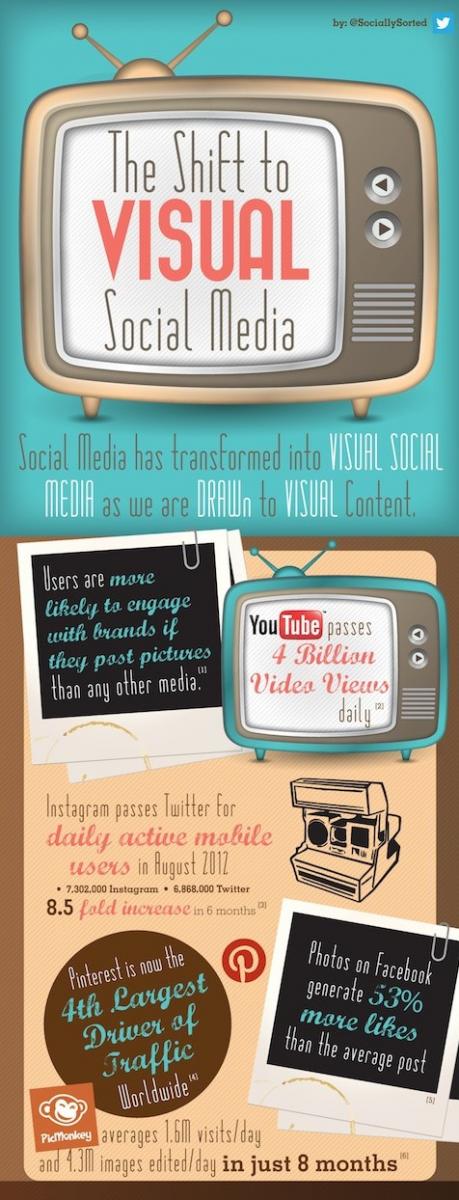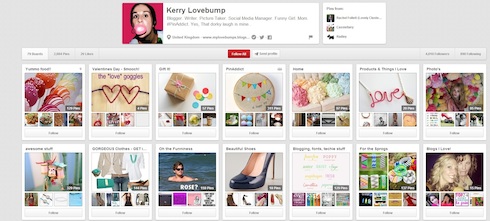By adaptive - January 22nd, 2014
Leverage your visual tools to create stories around your brand and deliver greater social impact
The value of content on social media networks is undeniable, but there is a new trend in town, one that can take your ideas and sell them and create stories around your brand - visual. Images, videos, infographics and more, these have become an increasingly powerful force in the world of social marketing and you need to understand how to leverage them to your advantage.
Fannit.com has created an infographic that illustrates this point perfectly, highlighting some of the most important reasons why you need to make visual content a priority.
At the recent Forrester Forum for Marketing Leaders in May 2013, the CEO of Kiosked said that it is the “dawn of the hyper visualization age. Internet is boundary free and increasingly visual. New technologies are enabling hyper visualization, where any object in any piece of media is a portal to other media, creating a new engagement point for brands.”
“People love visuals and people love information, even if it doesn’t directly relate to them, that’s why we’ve seen an increased growth in infographics over the last few years,” says Mike van der Heijden is the SEO Director at AtomicSearch.
Visual content marketing isn’t new, but it is leading the pack for social trends in 2014. The goal is to create an experience for the reader that will inspire them to interact with your brand and appeal to them on a basic level. As the infographic above points out, human beings are visual creatures and you need to find out what your customers want to see, and what they want to share and then you need to give it to them.
A recent survey undertaken by Newsreach in the UK emphasised that the way in which people share content is a vital part of the value of content marketing. Those surveyed said that: “visual content is the most effective for social sharing, with industry news and blogs coming in second.”
Sharing is what spreads your brand message across a vast network of interconnected consumers and has the potential to affect the ever-important bottom line. A visual gone viral is the social marketer’s dream come true.
Visual impact
Tapping into the power of visual media asks for more than just a well-placed picture with a snappy punch line. There needs to be a strategy and it must sit within your own brand identity.
“If you’re going to be sharing information and data in a visual manner, make sure it’s interesting and that the data is correct,” says Van Der Heijden, “The last thing you want is people dissecting your infographic or white paper and pointing out mistakes and errors.”
Kathryn Jeffries, head of media, content, PR and social media at Equimedia Limited outlines two ways in which you can leverage the power of visual to your brand’s benefit:
-
Start with the idea and the hook, which relates to the audience and then consider the best way to visualise the idea and promote it.
- Do your research to ensure that the idea itself resonates with the audience. Content will not be shared just because it is visual, it must be relevant and unique.
People want to be entertained and if you can be the one that does this with aplomb and a splash of branding, then you are well on your way to harnessing the potential of visual. Ensure your content is relevant and valid, keep it within your brand identity and don’t be tempted to go for quantity over quality. Tell the reader a story, use images to create a connection and draw them into your world.
This infographic by Socially Sorted, an agency that specialises in visual content, sums it all up perfectly:
A thousand words
A picture is worth a thousand words, but never underestimate the importance of metrics and measurements and getting it right. The Newsreach survey mentioned above found that 83% of companies invested in content marketing in 2013 compared with 78% in 2012 and the majority of respondents indicated that they were planning on spending more in 2014. With all that money dropping onto content it needs to have some way of being tracked and its value assessed.
According to Shawn Roos, Digital Director at Joe Public a clearly defined metrics strategy once you have the final content but rather form part of the content strategy as a whole.
“When discussing content you should always have a column for success metrics and be considering how that content item’s success will be measured,” says Roos, “There are numerous tools out there to track and a mistake that many make is letting a tool’s feature set dictate strategy. Rather decide what you’d love to be able to track and chances are there’s a tool that can.”
Karen Webber, Head of Marketing at Axonn Media, agrees, “It’s clear with the popularity of the likes of Instagram, Pinterest and YouTube that now visuals need to be considered from the planning stage. That means approaching visual assets in the same way as you would other content types by identifying the key message and setting clear objectives and parameters for success.”
Mike van der Heijden uses Sprout Social to track engagement, create reports and monitor what’s being said about the brand as well as through the analytics provided by social media platforms. Tracking the content that brands create can be done through the various tools outlined here, and, of course, no piece on the importance of visuals would be complete without a comprehensive infographic on the best social measurement tools.
Curated and pinned
Perhaps one of the best ways to examine the value of visual is through Pinterest, the fastest growing platform for online content sharing in 2013 according to ShareThis and the one place where brand visuals are curated alongside thousands of other images in vast shelves of bright, beautiful and rich content. We chatted to Kerry Davies, a Pinterest power user with over 4000 followers to find out why she is as comfortable pinning your brand images as she is pictures of food and gift.
Useful Social Media (USM): What draws you to Pinterest and what keeps you coming back?
Kerry Davies (KD): Clear, organized content management. It's a reflection of my personality to my followers and helps me to engage with my online community by sharing interesting things I have found across the Internet. I also draw huge inspiration from those I follow and never fail to find something to blog about if I have writers block!
USM: Why pin the images from brands?
KD: I use it to both create content for my blogs and as a space for relaxation, drifting into my own Pinterest dream world. I select a brand that I already like and use, or something I would like to try and want to remember for a later date.
USM: What are the criteria that make you feel that a brand or product is worth adding to your personal portfolio?
KD: How interesting they are, the price, clear images, how useful the product is and how relevant to our lifestyle or my blog readers.
USM: Why do you spend time curating content that includes brands?
KD: I write two blogs, a lifestyle blog and a blog inspiring others to create things they have found on Pinterest, be it a recipe, an outfit they've put together, a DIY body scrub - absolutely anything really! Brand sponsorship is always helpful for our monthly prizes and for creative content for the site, so we use Pinterest as a way of marketing their product, using the product to provide fresh content on the site and building a relationship with them.
USM: Do you think that brand identity even matters within the context of Pinterest?
KD: Absolutely! I think it's extremely important for brand building and for consumers to see the brand as a 'personality'. Pins should empower the consumer, help them by way of tips or tutorials, using the brand as well as promoting their products. It's a fine balance but once achieved, proves to be highly successful.
Next Reads
June 2014, New York
Become a social business: For superior marketing response, sharper corporate decision-making, enhanced innovation and a happier, more loyal customer
Brochure Programme



